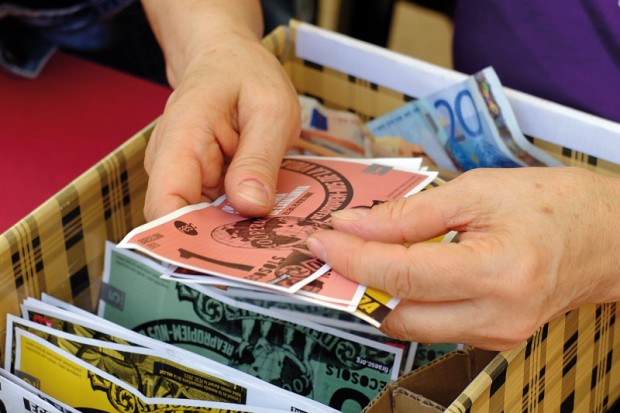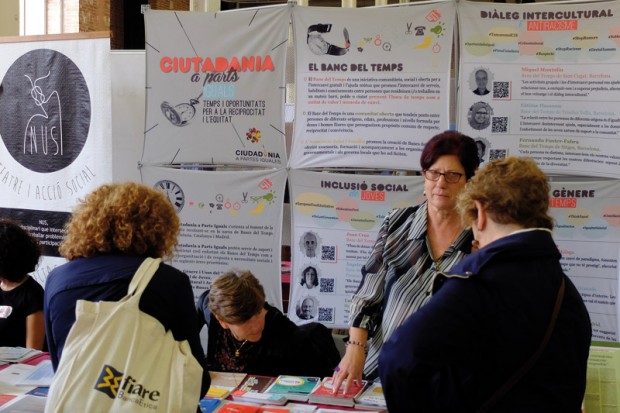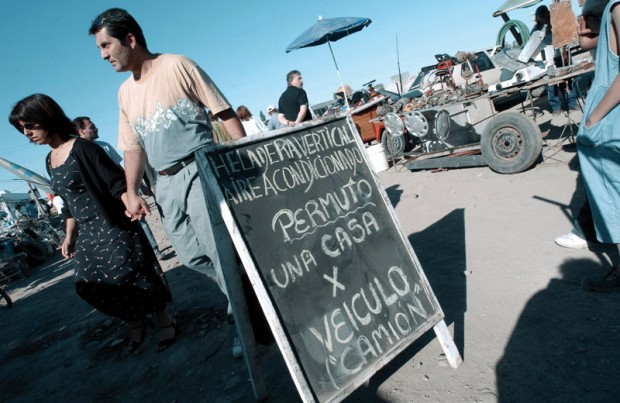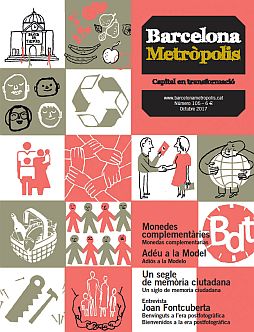
The ecosol, the paper currency used at the Solidarity Economy Fair held every year at the Fabra i Coats grounds in Sant Andreu.
Photo: Vicente Zambrano
Complementary currencies are systems created on the fringes of official currencies to promote economic, social and environmental projects. They also assign value to local activities and resources that are not found on ordinary exchange circuits.
The current monetary system has the same flaws of any monopoly: one has to use the prevailing currency even if it is not performing entirely satisfactorily, thus hindering the development of innovating methods to satisfy existing needs. If people understood the price they paid as a result of the inflation and periodic instability caused by using a single currency instead of taking advantage of other currency types, they would realise how extortionate it is. The solution requires, among other measures, the diversification of currency types, introducing other types designed to increase the availability of money for its primary function of exchange, rather than for savings or speculation.
Using the Taoist vocabulary of yin and yang, the following comparison between official legal tender and this new focus on complementary currencies can be made: it would mean progressing from searching for certainty to being able to tolerate ambivalence; from centralised authority to mutual trust; from competition to cooperation; from the predominance of technology to the predominance of personal skills; from physical and financial capital to natural and social capital; and from commercial transactions to community exchanges.
Complementary currencies are monetary systems that are created on the fringes of a country’s official currency with the aim of promoting economic, social and environmental projects. At the same time, they assign value to local activities and resources that are not found on ordinary exchange circuits because of a shortage of official currency.
These types of currency are also categorised in other ways: for example, as “alternative currencies”, because in certain contexts they replace conventional currencies; as “community currencies”, because they function in communities of people or entities that relate directly with each other and wish to establish a different method of exchange; as “local or regional currencies”, because they are in circulation in specific places or spaces; and as “social currencies”, because they are created, issued and controlled by groups and for social objectives. Nevertheless, their categorisation as “complementary currencies” is the one that best reflects one of the main characteristics of this type of currency: to complement, rather than to replace, conventional currencies. The other adjectives are implicit, since what they promote is alternative, community, local or regional, and social.
Money is used as a method of exchange, store of value and unit of account. It is only in the contemporary era, however, that these functions have resided in a single national currency. Throughout history, different forms of money have performed these functions independently.
An ancient precursor: the barter system
The earliest precursor of complementary currencies is bartering, that is, exchanging goods without the use of conventional money. Nevertheless, barterers are caught in a triple bind: it requires that the two parties each want to part with something, that each party has the item desired by the other and that said item has a value equivalent to the object wanted in return. As a result of these difficulties, and in an effort to establish equivalences and make exchanges, people began to use valuable or frequently used things as money to facilitate multilateral bartering.
Various examples of the use of complementary currencies being combined with conventional money systems have been documented since the 1930s: in Germany there was the Wära; in Austria, the Wörgl; in Switzerland, the WIR, and so on and so forth. These currencies responded to the need for alternative ways of buying family provisions after the 1929 Crash, although the majority were ultimately banned by their respective governments, with the exception of the Swiss WIR, which is still in use today.
Half a century later, in 1983, Canada established Local Exchange and Trading Systems (LETS), which were soon adopted in England, New Zealand and Austria and, later on, in the United States, Australia and Europe. Elsewhere, the Fureai Ticket emerged independently in Japan, as did the Ithaca HOUR in the United States.
Although complementary currencies have always existed in parallel to those currencies backed by the State, they seem to have greater appeal during periods of recession or economic crisis, when there is a lack of paid work and money. That was the case in Argentina. The country’s economic collapse in 2001 provided an impetus for alternatives to traditional credit systems for hundreds of thousands of users.
Social, economic and environmental impact
For some writers, the overriding objective of complementary currencies is to improve the social well-being of communities, since they meet certain psychological needs such as recognition, a sense of belonging, trust, social involvement and self-esteem, among others. Since everyone has something to offer, including skills not necessarily valued by the formal labour market, complementary currencies are a tool that can help empower marginalised groups. These effects add to the rise in community spirit and networks of friendship and collaboration.
Complementary currencies are also instruments for building local economic circuits to prevent wealth from flowing out of a community, thereby having an exponential effect on the local economy. Informal labour, skills exchange, volunteering and domestic work can be valued, recognised, compensated and even exchanged using these currencies. Such currencies therefore offer an alternative way of accessing goods and services for persons who are financially excluded from or unable to find work in the formal system, and provide support for sustainable economic development through small local firms that show loyalty to the community.
Complementary currencies also have a positive environmental impact, since they reduce the ecological footprint by creating more local consumption models and substituting imports, and reduce the energy needed for transportation. In addition, they encourage the exchange of local products and even the reuse of products. Some of these currencies stimulate more environmentally friendly behaviour by incentivising residents to take part in recycling programmes, make more sustainable shopping choices and use public transport. Moreover, they foster the development of new environmental technologies, as in the case of currencies that support renewable energy production.
According to data collected for a 2013 study into the historical and international evolution of complementary currencies, Gill Seyfang and Noel Longhurst identified a total of 3,418 projects in 23 countries across every continent. A project is understood as a minimum of five different initiatives of the same type of complementary currency within the same country. The study established four types of complementary currency: time banks, mutual credit systems, local currencies and barter markets.

A time banking stand at the Solidarity Economy Fair at the Fabra i Coats grounds, which this year held its sixth edition. Time banking is the commonest type of complementary currency, present in eleven countries and four continents.
Photo: Vicente Zambrano
Time banks
Time banks are the most common type of complementary currency, with 1,715 projects (representing 50.2 per cent of the total) in 11 countries on 4 continents. Time banks are based on the exchange of a participant’s time to help another person or organisation. Each person’s time has the same value, irrespective of the service they provide. Some projects are organised in neighbourhoods or communities and usually run by volunteers, but others are established by institutions. They often focus on a specific sector, such as health or education, and are committed to building social capital, inclusion and cohesion through residents, social assistance, community-based activities and reciprocal volunteering.
One of the first examples of a time bank was recorded in Japan in 1973 and was called Fureai Kippu, although it may not be considered as the driving force behind these types of system. It was in 1986 in the United States that the concept of time banks really developed in marginalised neighbourhoods with the aim of rebuilding communities and restoring the dignity of disadvantaged persons. The model expanded rapidly throughout the United States and was adopted in the United Kingdom in 1997. Since then, major networks have emerged and have developed new methodologies and enhanced existing practices, while simultaneously providing support for new projects around the world in countries such as Italy, Spain, Portugal, New Zealand, Finland, Canada and Japan.
Mutual credit systems
The second most common type of complementary currency is the mutual credit system, with 1,412 projects (41.3 per cent of the total) in 14 countries on 5 continents. Members of a community advertise their services and requests in a directory, while a central accounting system is responsible for recording transactions. The currency itself is created when a sale and purchase transaction is made in which both the buyer and the seller commit to the system. The credit of one person is equal to the debit of another, with the result that the balance is always zero. These systems occur in the context of civil society, often with little support from the State or other sources of funding. Although they are aimed at supporting local economies, it is the social advantages and the sense of community that have the biggest impact through the social networks they promote.
Local Exchange and Trading Systems (LETS), which were first established in Canada in 1983, are the best known example of this kind of system. Their initial objective was as an emergency currency during recession. LETS were rapidly expanded throughout Canada and then to the United Kingdom, New Zealand and Australia through networks of environmental activists. Their growth peaked towards the end of the 1990s in the United Kingdom, and a few years later the initiative reached the rest of Europe. Variations on the LETS model can be found in France, Hungary, Germany, Austria, Switzerland and Australia, while there are similar approaches in South Africa, Japan and Canada.
Local currencies
Local currencies are the third most common type of complementary currency, with a total of 243 projects (7.1 per cent of the total) in six countries on four continents. Local currencies are monetary systems that are bound geographically to a specific region and are aimed at promoting local economic activity. While some of these systems do have a physical currency, the majority function though digital or mobile platforms. Their aim is to complement the national currency and accelerate local interchanges without displacing interregional trade.

Notes of different values in hours, the alternative local currency created in the city of Ithaca, in the state of New York, in 1991.
One case worth highlighting is the HOURS local currency, which originated in Ithaca, New York, in 1991. There have also been other projects in the United States, Canada and other countries, most of which are linked to environmental or alternative groups. The German Regiogeld system centres on local economic development and is supported by a powerful exchange network. Brazilian community banks are aimed at driving local economic activity in marginalised regions.
Transition Currencies is yet another model. Founded in the United Kingdom in 2007, it has developed into five different currencies. While there is no formal network between them, they share knowledge and experiences of electronic payment mechanisms in order to increase uptake among users. To a greater or lesser extent, they are associated with the decrease in transition towns and are aimed at rebuilding local economic resilience.
Barter markets
Barter markets, the fourth most common complementary currency, with 48 projects (1.4 per cent of the total) operating in four countries on two continents, are systems aimed at overcoming cash shortages and fostering exchanges between a group of users, usually in a regular marketplace. They tend to use physical tender to manage balances, which are often issued to new users as interest-free loans to enable them to participate in the market. They are frequently associated with the idea of prosumers, that is, individuals that simultaneously produce and consume. Barter markets are a hybrid between local currencies and mutual credit systems, with a new infrastructure so that people can exchange goods and services within a specific event, limited space or without the need for cash.

A barter market in the Argentinian city of Mendoza, November 2002. Barter clubs spread rapidly in this South-American country following the economic collapse from 1999 to 2002.
Photo: Darren McCollester / Getty Images
The concept first emerged in Buenos Aires in 1995 as a sustainability initiative at a time of deindustrialisation and economic crisis. It rapidly expanded during the country’s economic meltdown of 1999 to 2002, and became a way of life for a large demographic group. Nevertheless, Argentine barter clubs were severely hampered by network rivalries and suffered a catastrophic collapse in credibility from 2002. Even so, some clubs continue to operate, and similar models have sprung up in Venezuela, Mexico and other South American countries, where they are still associated with the idea of economic solidarity. In Canada, on the other hand, initiatives have emerged to provide support for sustainable development by reusing goods.
According to the study conducted by Gill Seyfang and Noel Longhurst, Europe is the continent with the greatest number of projects — 2,333 (68.3 per cent of the total) — of which more than half (54.1 per cent) are mutual credit systems, 44.4 per cent are time banks and just 1.5 per cent are local currencies. Another study, carried out by Neil Hughes in 2015 and using the same classifications as Gill Seyfang and Noel Longhurst, found that there are a total of 372 initiatives in Spain: 290 time banks, 71 mutual credit systems and 11 barter networks. Catalonia is the autonomous community with the greatest number of initiatives (97), ahead of Andalusia (61) and Madrid (51). The 97 Catalan initiatives include 71 time banks, 23 mutual credit systems and three barter networks.
Some current initiatives were not taken into account in that 2015 data, such as the local currencies established by certain Spanish city councils. In addition, most of the existing initiatives meet the requirements of at least two of the four categorisation types. For example, there are local currency initiatives that also reproduce mutual credit systems, and mutual credit systems that also take into account the conversion of their unit of exchange with time bank hours.
Integrating the data from the two above-mentioned studies with many others and creating an updated repository of truly functional complementary currencies are no small challenges, given the disparities between the classifications used for their categorisation and the difficulties associated with identifying their degree of functionality. The creation of an updated, homogenous database, both in Spain and globally, is a pressing task to enable complementary currencies to be consolidated and demonstrate their potential. Without it, confusion and a lack of coordination and control reign supreme, which impedes awareness-raising about these currencies and hinders their ability to grow and effect social change. For that reason, a database is one of the goals of the Money and Securities research and working group of the Economics and Business Studies department at the Open University of Catalonia (UOC), with support from the Social Currency Institute (IMS).



